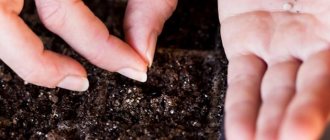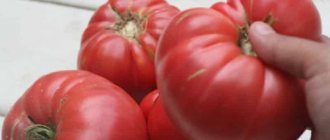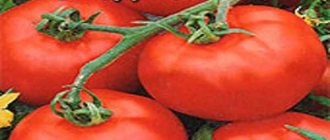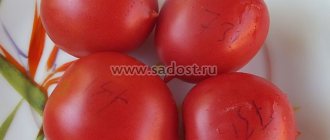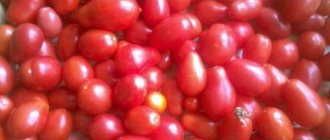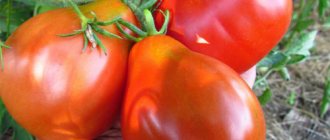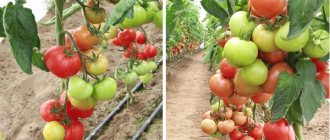Tomato Divo marvelous is an extraordinary variety, which is characterized by high yield, giant fruits with a taste of 5 plus. Designed for protected beds.
| Height | Landing location | Ripening time | Fruit color | Fruit size | Origin | Fruit shape |
| Tall | Greenhouse | Mid-season | Pink | Large | Variety | Flat-round |
Tomato is amazing for everyone!
The agricultural company specializes in the selection and seed production of F1 tomatoes, offering high-quality seed material to both private owners and vegetable farms and farmers. Tomato Divo is an original hybrid belonging to the group of early ripening tomatoes.
The first “wonderful” fruits can be harvested 100 days after the tomatoes emerge. The hybrid is distinguished by its tall, spreading bush. The height in the greenhouse can reach 1.7-1.9 meters. The indeterminate tomato bush is medium-leaved, with medium-sized leaves of intense green color.
The inflorescences are simple, the first one is formed already above the 8th leaf, then the flower clusters go through three leaves. The tomato has a beautiful appearance, especially when the time comes for fruiting and ripening of tomatoes. The fruits are smooth and round. Until fully ripe, they have a light green color; near the stalk there is a darker large spot. When biological maturity is reached, the color is bright red. There is slight ribbing on the surface of the tomatoes. The skin and pulp are dense, the chambers (usually 3-4) contain a small number of seeds. The taste of the fruit is good, there is an aroma.
Many gardeners believe that hybrids are inferior in taste to varieties, but this is a subjective judgment. It is difficult to always evaluate the final result and quality of the fruit, since a lot depends on the weather, tomato growing conditions, care, and correct adherence to agricultural technology.
Average weight is 120-150 grams. The manufacturer recommends using fresh tomatoes. Hybrid fruits are suitable for processing: sauces, pastes, purees, lecho.
Divo fruits have good shelf life and are suitable for transportation. Judging by the reviews, tomatoes retain their taste and commercial quality when stored for up to one month.
Tomato Divo: variety description, reviews, photos
Tomato Divo is another indisputable success of Russian breeders, a relatively recent product from the famous agricultural company Ilyinichna, which produces and distributes seed material and has long been known to domestic gardeners.
Tomato Divo, according to many plant growers, is truly a marvelous product. This is a tall, proprietary hybrid from an agricultural company that in a short time was able to earn an excellent professional reputation thanks to the successful qualities and productivity of its hybrids.
Characteristics and description of the variety
Tomato Divo, bred by domestic breeders, is a varietal hybrid. It belongs to the early ripening varieties. The harvest can be harvested 100 days after the first shoots appear. Indeterminate, spreading with medium filling of the foliage crown, growing well when formed into 2 stems. Under optimal conditions it reaches 170–190 cm in height. The leaves of the variety are medium green, the stem and root system are strong and powerful, the fruits are round, slightly ribbed, rich, intense red, with an average weight of 150–200 g.
With skillful agricultural technology and up to 250–300 g. The main purpose of the variety is fresh consumption, use in various culinary needs, canning salads, sauces, and dressings for first courses are prepared from it. The variety is not very suitable for canning in its entirety, because it is large-fruited, but it is very suitable for pickling and pickling for the winter.
The characteristics and description of the variety may be of interest to both specialists and amateurs. The variety has excellent yield (about 10.5 kg per sq. m. with poor agricultural technology). Reviews from vegetable growers who have already grown the Divo tomato and photos posted on special forums and gardening websites all indicate that this is indeed a wonderful hybrid. Despite the relative youth of the varietal hybrid, it has already been included in the State Register and is on the list of tomatoes recommended for growing under film cover.
The variety has a lot of advantages that growing an early ripening hybrid can provide, from its high yield and early ripening to its excellent resistance to almost all diseases of nightshade fruit crops. The photo of this tomato variety shows quite large fruits (120–150 g), which the manufacturer recommends for fresh consumption. Many farmers say that Divo tomatoes grown in open ground have an excellent taste and aroma that is no worse than fruits grown in a greenhouse. The variety can be used for making juices, tomatoes, lecho and other vegetable preparations produced for the winter.
The variety is recommended for cultivation in greenhouses and under film covers in any regions of problematic agriculture. It is stress-resistant, calmly tolerates the absence of conditions required for other varieties, is immune to diseases characteristic of tomatoes (fusarium, viruses and fungi), is characterized by high yield and the ability to bear fruit throughout the growing season.
Reviews from farmers involved in breeding the variety for sale indicate a high commercial yield of the product with minimal cultivation costs. The average yield is 10.5–10.6 kg per bush. This is not the highest indicator for hybrids, however, its unpretentiousness and the lack of special conditions for its cultivation indicate the preferable choice of the variety as a crop for greenhouse cultivation.
Advantages and disadvantages of the variety
The main disadvantage of the variety is its ability to reach high growth rates, which is not always convenient in greenhouse conditions. However, people who have been growing tomatoes in a greenhouse for a long time say that if the bush is pinched and properly reinforced, its growth can be limited, and with the right agricultural techniques, even used as an advantage when harvesting.
Let's consider some advantages of the variety:
- this is an original varietal hybrid from a proven domestic producer, an originator with a high professional reputation;
- tall and strong plant with a powerful root system and strong stem;
- the yield is much higher than that of many popular varieties put into industrial production;
- the fruits are large, fleshy and juicy, with excellent taste qualities for a hybrid variety and an excellent and attractive appearance;
- resistance to many diseases characteristic of fruiting nightshades and the ability to escape some of them due to early ripening;
- the ability to retain taste for a month if the correct storage conditions are observed;
- good tolerance to long-term transportation and preservation of presentation;
- the possibility of making a profit from commercial breeding due to the high commercial yield of the product and the high market value of early varieties;
- suitability for fresh consumption, for any culinary needs, including for sealing canned vegetables, preparing sauces, tomato and dressings for first courses, pickling and fermenting in barrels for the winter;
- the pleasant property of producing crops throughout the growing season, with constant preservation of high yields and large fruit size with proper agricultural technology;
- early ripening speed: within 100 days from the appearance of the first shoots.
Features of growing and caring for the variety
No special conditions are required for growing a hybrid in a greenhouse, or, in any case, they do not differ from the conditions created by standard red-fruited varieties with tall bushes.
When planting seeds in a common container, it is necessary to pick the seedlings at the level of 2-3 leaves; if planted in separate pots, you can do without this labor-intensive process.
Divo is an optimal and high-yielding hybrid that can be safely recommended for industrial cultivation.
The value of the Divo hybrid
This tomato, despite its small age, is already included in the State Breeding Register and is recommended for cultivation in all regions of the country under shelters.
Divo is an early tomato that can withstand all weather troubles: temperature changes, prolonged precipitation. It produces good yields even in conditions that are quite extreme for tomatoes, so it can also be grown in risky farming areas.
A short summer is not a threat to it; thanks to the seedling method, short growing season, quick and friendly harvest, you can get very good results in regions such as the Urals, North-West, and Siberia.
Also, the Divo F1 tomato is valued for:
- unpretentiousness;
- good taste of fruits;
- productivity (up to 10.4-10.6 kg per square meter);
- large fruit;
- resistance to a wide range of diseases.
ON A NOTE! The Divo tomato is indet and has a large height, and this must be taken into account when planting plants in a greenhouse.
Reviews from those who grew it show its resistance to fusarium, tobacco mosaic, and cladosporiosis. Thanks to its early ripening, the hybrid successfully “escapes” late blight. In addition, its high tolerance to shade is noted. It does not reduce productivity in low light conditions, which can also be considered a plus.
Divo F1 seeds are on sale, produced by Agro, which is the originator of the hybrid. You cannot collect your own seeds from Divo tomatoes, so you need to stock up on seed material for the season in advance.
Description and characteristics of the variety
Tomato Divo marvelous is an indeterminate tall variety. The bushes grow up to 2 m in height. The shoots are distinguished by their strong foliage and bushiness. Requires garters, pinching, shaping. 1 inflorescence is formed through 9-10 leaves.
There are 7-9 fruiting clusters, each with up to 10 tomatoes.
Fruit characteristics:
- round and flattened shape;
- salad purpose;
- ribbing is weakly expressed;
- weight 250-400 g;
- color raspberry red.
Ripening time is average - 120-130 days from germination.
Site selection and soil preparation
You need to think about summer harvests in the fall when identifying a site for growing tomatoes. Hybrid F1 Divo is recommended to be grown in a greenhouse, so in the fall you need to:
- carefully dig up the soil in the greenhouse;
- add humus or rotted compost;
- add ash (two glasses each);
- add superphosphate (60-80 grams each).
The standards are given per square meter.
IMPORTANT! On sandy soils, it is recommended to apply potassium fertilizers in the spring.
Before digging, the greenhouse is disinfected (you can treat it with a smoke bomb). In the spring, dill and salads can be sown in the greenhouse beds before the tomatoes, covering them with non-woven material. This will not only allow you to get a harvest of greenery, but also cultivate the soil and reduce the number of colins in it.
Tomato 'Divo F1'
Latin name: solanum lycopersicum 'divo f1'
Main genus: Tomato
| Productivity |
|
| Ripening period |
|
| Soil type |
|
| Growing method |
|
| Purpose of fruits |
|
| Disease resistance |
|
| Soil ph requirements |
|
| Life form |
|
| Shape of fruits/stems/roots and tubers/heads |
|
| Size of fruits/stems/roots and tubers/heads |
|
| Cultivation region by origin |
|
| Vitamin content |
|
| Color of fruits/roots and tubers | |
| Peel thickness |
|
| Frost resistance |
|
| Drought resistance |
|
| Decorative value |
|
| Taste of fruits |
|
| Shelter for the winter |
|
| Pest resistance |
|
| Habit |
|
| Keeping quality |
|
| Parthenocarpic |
|
| Branching pattern |
|
| Density and character of the pulp |
|
Expand all properties
Description of the plant:
Tomato 'Divo F1' is a hybrid bred by Scientific and Production Agro LLP. Approved for use throughout the Russian Federation in 1999.
Recommended for garden plots, household plots and farms. They are grown in spring-summer rotation (in film greenhouses). The hybrid is valued for its resistance to extreme growing conditions.
Dimensions and growth form:
The hybrid 'Divo F1' is represented by indeterminate, medium-sized plants with weak foliage. Medium sized leaf, green.
The inflorescence is simple. The first inflorescence is laid above the 8–9th leaf, the subsequent ones - after 3 leaves.
Fruit:
Size, shape and color:
The fruits are smooth, large, round in shape, weighing 150 g. The surface is slightly ribbed. The color of the unripe fruit is green with a dark green spot at the stalk, while the ripe fruit is red. Number of nests 3–4.
The taste of the fruit is excellent.
Ripening time and yield:
Tomato 'Divo F1' is an early ripening hybrid. Fruit ripening occurs on the 101st day after full germination. The hybrid is characterized by friendly yield. Productivity 10.4 kg/m2.
Disease resistance:
The hybrid is resistant to tobacco mosaic virus, fusarium and cladosporiosis.
Directions for use:
Recommended for fresh consumption.
Getting ready to grow seedlings
In order to start sowing seeds, you need to prepare the soil and containers for tomatoes in advance. You can use ready-made mixtures from specialized stores, but you should only take soil that contains the exact composition. Peat mixtures will have to be deoxidized, otherwise there is a high risk that the seeds simply will not sprout in such soil.
When using store-bought soils, it is best to mix them with other components (depending on the composition of the soil) to obtain high-quality soil for seedlings. When preparing the soil yourself, it is recommended to take leaf or turf soil, peat, sawdust, and coarse river sand. The main thing is that the soil for growing tomatoes should be loose, moisture-permeable, light, without any foreign impurities.
Seeds from the store do not need to be disinfected, but only soaked in a growth stimulator and placed in a damp cloth for germination. Many gardeners sow hybrid seeds directly into the soil, since usually producers have already completed all the pre-sowing treatment in advance.
The optimal age of hybrid seedlings before planting in a greenhouse is 60 days. Accordingly, taking this into account and the time of planting (mid or late May), you can calculate the time for sowing the seeds, adding another week for their germination.
The best sowing time for the Divo hybrid is mid-March. By mid-May, the seedlings will be up to 55-60 days old, and in the middle zone conditions they are quite suitable for planting under cover.
Growing containers:
- wooden, ceramic, plastic boxes;
- peat pots;
- plastic glasses;
- sachets;
- homemade paper cups.
Usually, tomato seeds are sown first in common containers, and then, as soon as the seedlings have 2-3 true leaves, they are planted in separate cups.
Temperature for seed germination is at least +24ºC…+25ºC. After the first shoots appear, the tomatoes are exposed to light. The temperature is reduced to +18ºC for a week, and then returned to +22ºC...+24ºC.
Picking a hybrid and care before disembarkation
Many people know about the need for such a procedure. For tomato seedlings, picking is important because it allows you to build a powerful and developed root system. And such plants will bear fruit better.
Tomatoes are picked in the phase of 2-3 true leaves. Some gardeners even practice a second picking, planting tomatoes after about three weeks in large containers. After picking, water the plant no earlier than 5-6 days later.
Further watering is carried out only taking into account plant growth, indoor air temperature, and lighting. If the weather is sunny, then the plants on the windows experience intense evaporation, then you will need to water more often.
IMPORTANT! It is better to underwater tomato seedlings than to overwater them. Excess moisture in the soil must be avoided.
The hybrid already at the seedling stage requires good nutrition. To fertilize tomatoes, you can use various complex fertilizers, but before that you should study their composition. It is desirable that they contain more potassium, which is beneficial for tomatoes, and a little less nitrogen. It will be enough to feed Diva twice.
Before planting, the seedlings must be hardened two weeks before, taking them out into the fresh air (on the balcony, veranda). If this is not possible, then it is recommended to spray the bushes with a solution containing EPIN the day before (to reduce stress during planting). High-quality seedlings have a strong and stocky stem, leaves are rich green in color, and the first cluster is in the budding stage.
Divo - variety of tomato plant
Variety characteristics:
Properties of the Divo variety:
Recommended region on the map:
Information on the admission of Tomato Divo from the Register of the State Variety Commission of the Russian Federation
Application for admission No. 32124, registered 1999-01-05. The Tomato Divo variety was included in the register of approved varieties in 1999. Approved for use in regions: All regions.
The originator of the Tomato Divo variety is:
Other varieties of tomato plant
Search for variety by name
Variety selection
Question to the portal experts
If you haven't found the answer to a question, don't hesitate to ask an expert.
Have you already planted Tomato Divo?
Tell us if you liked this variety? Will you plant it again?
Register or Login so you don't have to enter your Name and Email every time
Thanks for the comment! It will be published after checking by a moderator!
No comments yet, be the first!
A portal for those who love their dacha
Your question has been sent for moderation. Don't worry, we quickly check your questions and your question will be answered within 1 day.
Planting tomatoes in a greenhouse
The timing largely depends on the climate of the area and weather, since everyone’s conditions are different. Usually, tomatoes can be planted in a greenhouse in the middle zone starting from the beginning of May. In a cold spring, there is no need to rush, the soil should be warmed up to +16ºC, and daytime temperatures should not be lower than +20ºC…+22ºC.
In the conditions of the North-West and Siberia, tomatoes are planted later - at the end of May or even the beginning of June. Holes are prepared for plants, guided by the scheme - no more than 3 hybrid bushes per square meter. The holes are spilled with water, superphosphate (half a teaspoon) is added there, then the tomato is carefully planted, the soil is sprinkled and compacted. Tomatoes are not watered for ten days after planting. This technique will allow the root system to penetrate deep into the soil and provide the plant with good nutrition.
Text version
Dear friends, hello, now we will tell you about the features. The varieties of tomato are marvelous, especially the coloring of the fruits. This variety is sort of colored, half pink, half yellow-orange, this indeterminate large-fruited, medium-sized variety is recommended for growing in film greenhouses.
Tomato bicolor variety
When grown in a greenhouse, the height reaches up to two meters, the first ti is laid from the signum leaf further through two or three leaves of the fruit phase? Technical ripeness is green with and significant with a dark spot.
Are the fruits yellow at the base of the fruit in the phase of biological ripeness during the transitional stage? When ripe, the lower part of the fruit becomes pink brushes in this variety of intermediate type upper part! Simple clusters are formed of six large fruits, an early-ripening variety in film greenhouses.
Video: THE MOST PRODUCTIVE AND TASTY VARIETIES OF TOMATOES according to collector Lyudmila Kodzasova
Video: The best varieties of fleshy tomatoes. 5 varieties of large-fruited tomatoes. Tomatoes 2021 Siberian selection.
Tomato bicolor
For logically ripe fruits comes after 95 103 one hundred and five days of dependence on agricultural technology? Cultivation and environmental conditions, the variety is recommended to be formed into one stem since it has very large fruits; the planting scheme is recommended for the 1st. Varieties at 70 centimeters between rows and 35-40 centimeters between plants in a row are quite high!
It is tied sti in addition to having insignificant fruits: There is a 100 rib at the base of the fruit. In this variety, the face of satio fruits is also found. When quite large fruits are formed, the shape of the fruits is rounded and flat, as we have already noticed when ripening, the fruits have two colors, the upper half of the fruits.
Bicolor tomatoes
Part is yellow, the second half, the lower part acquires: A pink tint and it turns out that these two-color tomatoes have fruits that are quite dense, multi-chambered, and make up most of the fruit.
The pulp is light yellow in some areas with areas of pink coloring, quite the fruits are juicy fruits of this. Are the varieties recommended for fresh use and for preparing various salads?
Wonderful variety
As well as various culinary products, for example for making various sandwiches, sandwiches and so on, in addition, you can prepare from the fruits of this variety! Original yellow juice with an average fruit weight of 240-270 grams on plants can also form. Significantly large fruits, also colored yellow pink, weight reaches 550-570 grams, so respected.
Friends, grow tomatoes, they are not only tasty, they are also healthy, dear friends, subscribe to our channel for those who scratch an itch. Likes, send your comments, ask your questions, we will answer them with many, many delicious and different varieties of tomatoes, dear friends.
Tomato care
Tomatoes should be regularly watered and fed no earlier than 14-18 days after planting. Plants do not need abundant watering at the very beginning of the growing season, as this can lead to excessive growth of green mass (just like excessive application of nitrogen).
It is necessary to water rarely, but abundantly. Tomatoes need up to two liters of water per day, but it all depends on the weather, soil type, size and condition of the plant itself. The usual schedule is twice a week, in hot summers it can be up to three times a week.
It is recommended to water in the morning, but moisture should not get on the leaves of the plant. After watering, loosening is mandatory (if mulching is not carried out), and it is also necessary to ventilate the greenhouse.
ON A NOTE! Regular ventilation helps reduce humidity in the greenhouse and provides oxygen access to the root system of tomatoes.
Drip irrigation, which you can do yourself, always gives good results.
The first feeding is no earlier than 18-21 days after planting the tomatoes in the greenhouse. It is best to use water-soluble fertilizers, which are applied along with watering the tomatoes.
The choice of fertilizers is huge, and here every gardener prefers his own options. Some grow tomatoes without using chemicals, actively fertilizing the bushes with organic matter and ash. Others use ready-made formulations (this is convenient and effective), but in this case it is necessary to pay attention to the components and their quantity. During the season, up to 4-5 fertilizing of the hybrid is done in the greenhouse, and one or two foliar fertilizing is also carried out. For Divo tomato, you can use a solution that contains optimal potassium content (up to 20%), and also contains nitrogen, phosphorus, and magnesium. Fertilizing tomatoes with various fertilizers based on humic acids is very useful.
The tomato hybrid Divo requires mandatory formation. It is recommended to grow it in one stem, removing all side shoots and stepsons. This tomato, like all indets, has unlimited growth, so the top needs to be pinched.
Techniques for forming a tomato:
- timely removal of stepchildren (all) leaving a stump;
- pinching the top (above the 9th brush), while after the inflorescence two leaves are always left.
Indicating the pinching height of the growth point is conditional; the tip can be limited to any height.
Fruits are harvested in a state of technical maturity. It is advisable to remove the first tomatoes from Diva while they are still green to allow the plant to form subsequent fruits.
What are F1 tomato hybrids?
Some tomato lovers criticize hybrids and consider them less tasty and healthy than varietal ones. Others, on the contrary, choose them because they are more productive and less sick. Every year, new tomato products appear on the shelves of gardening stores, most of them hybrids.
What are hybrids
On packages of seeds, next to the name you can see the designation F1. It indicates that this is not a variety, but a hybrid form. The abbreviation stands for simply:
- F – the first character of the word children (filii);
- 1 – first generation.
Hybrid tomatoes are superior to varietal tomatoes in yield, early maturity, and disease resistance.
The cost of hybrids is higher. The explanation is simple - the work to obtain them is manual and lasts several months.
Their superiority is explained simply. A hybrid form is obtained by crossing 2 or more parent forms with pronounced varietal properties. The best qualities go to the new form. Hybridization is carried out in protected ground, the work is manual.
Differences between hybrid and varietal tomatoes
When purchasing seeds of a variety you like, an experienced gardener analyzes its characteristics at the end of the season: early maturity, yield, taste, color, care features. If everything is satisfactory, he selects high-quality, ripened fruits and releases seeds from them.
Next year there is no need to go to the store. You can use your own seeds. All varietal qualities are preserved. With F1 everything is different. You will have to buy seeds annually; getting yours from a hybrid form does not make sense. The second generation may unpleasantly surprise:
- the bushes will be of different heights;
- fruits differ in color, shape, size;
- productivity is low.
F1 benefits
By giving preference to hybrid forms of tomatoes, an amateur vegetable grower receives a number of advantages:
- the tomato harvest is many times larger;
- ripening time is reduced;
- fruits are one-dimensional, aligned in shape, color, weight;
- the pulp has a harmonious taste and a rich range of nutrients;
- plants get sick less often, suffer little from pests, and adapt well to weather conditions.
How tomato hybrids are bred
Hybridization is carried out only in protected soil conditions. Two varieties of tomatoes are planted. One variety will be a pollinator, the second a seed plant. Pollen from the pollinator is transferred with a brush to the pistil of the flower of the seed bush.
Pollinated flowers are marked and bags are put on them. To guarantee, the procedure is repeated after 2 days. Successful pollination will result in fruit formation. The bag is not removed from it until it is fully ripe. Seeds are released from fully ripened fruits. They are used for reproduction next season.
Productive hybrids
Greenhouse owners need tall F1 tomatoes. You will be pleased with the yield (up to 20 kg per bush):
Popular early ripening forms are slightly less productive: Semko Sinbad, Rosemary, Blagovest, Intuition.
The following performed well in open ground:
- Jaffa F1;
- Katya F1;
- Taman F1;
- Golden Andromeda F1.
Mistakes when growing hybrids
When buying seeds, they look at a beautiful photo, but don’t read the description. Tomatoes intended for the greenhouse are planted in open ground and vice versa. Many people do not use the greenhouse space productively and plant determinate, low-growing tomatoes in it.
It is more correct to grow vigorous hybrids (indeterminate) in protected soil; they grow to the top of the greenhouse and produce more fruit per unit area. Many people do not follow the recommended planting pattern and plant too often. There are established landing rules.
| Bush type | Scheme |
| 45*60 cm |
Other growing mistakes:
- improper formation of the bush;
- excessive application of fertilizers;
- poorly organized watering.
Tomato hybrids are worth growing. New products are pleasing not only with their resistance to diseases and high yields, but their fruits are distinguished by good taste and marketable appearance.
